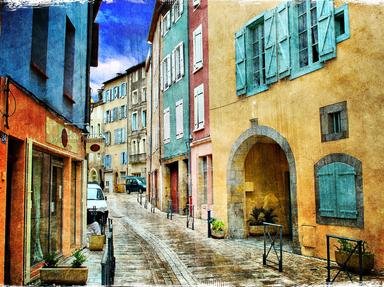Quiz Answer Key and Fun Facts
1. Perhaps the most infamous painting of the 1913 Armory Show, what "cubo-futurist" painting of the human figure by Marcel Duchamp was described by one critical viewer as "an explosion in a shingle factory"?
2. A representation of the Fauvist painting "Blue Nude (Souvenir of Biskra)" was burned in effigy by protesting art students when the Armory Show arrived at the Art Institute in Chicago in 1913. Which French artist created this painting - called by one critic "that toad" - when an unfinished sculpture fell and broke into pieces?
3. French artist Paul Cézanne's painting "Hill of the Poor (View of the Domaine Saint-Joseph)" introduced European Modernism to a wider American audience when an important New York City museum bought it after its exhibition in the Armory Show of 1913. What museum made this bold move?
4. Several paintings by a Dutch artist unfamiliar to most Americans at the time were exhibited in the 1913 Armory Show, including "Mountains at Saint-Remy (Collines ŕ Arles)", painted in 1889 in the year before his death by suicide. Who was this creative genius, said to have sold only one painting during his lifetime?
5. Constantin Brancusi, a Romanian sculptor who studied at the École des Beaux-Arts in Paris from 1905 through 1907, had five abstract sculptures in the 1913 Armory Show, including the egg-shaped "Sleeping Muse" and "Portrait of Mademoiselle Pogany" and the minimally blocky "The Kiss". What sculpture from the 1920s, part of a series, is perhaps his most famous, originally titled in Romanian "Pasărea în văzduh"?
6. On a 1913 postcard from the Armory Show exhibition the bright colors of the abstract painting "Improvisation 27 (Garden of Love)" seem to jump off the surface. Who was the Russian-born artist who created this work of modern art?
7. Out of the 300 artists presented at the 1913 Armory Show, 50 were women. Which American-born Impressionist artist, who often depicted women and children in her paintings and prints, disliked Cubism, Fauvism, and other modern styles exhibited along with hers, calling Henri Matisse a "publicity hound"?
8. A Danish-American artist involved in organizing the 1913 Armory Show dropped out because he felt the emphasis on modern art coming out of Europe clashed with traditional American art like his own. Who was this monumental sculptor known best for his designs for Stone Mountain and Mount Rushmore?
9. Some viewers of the 1913 Armory Show were shocked by Abastenia St. Leger Eberle's sculpture "White Slave", which graphically depicts the greed and misery of human trafficking in the sex industry on Manhattan's Lower East Side. Into what American art movement can Eberle be classed, one that realistically depicts the seamier elements of street life that the middle and upper class sought to ignore?
10. Historian of modern art Sam Hunter cites three paintings that "came to exert the most seminal influence on American painters" after the 1913 Armory Show. Two of these are Marcel Duchamp's "Nude Descending a Staircase" and Francis Picabia's "Procession at Seville". What is the third, actually painted after the Armory Show by a futurist Italian-American New Yorker later famous for his geometric paintings of the Brooklyn Bridge?
Source: Author
nannywoo
This quiz was reviewed by FunTrivia editor
looney_tunes before going online.
Any errors found in FunTrivia content are routinely corrected through our feedback system.

